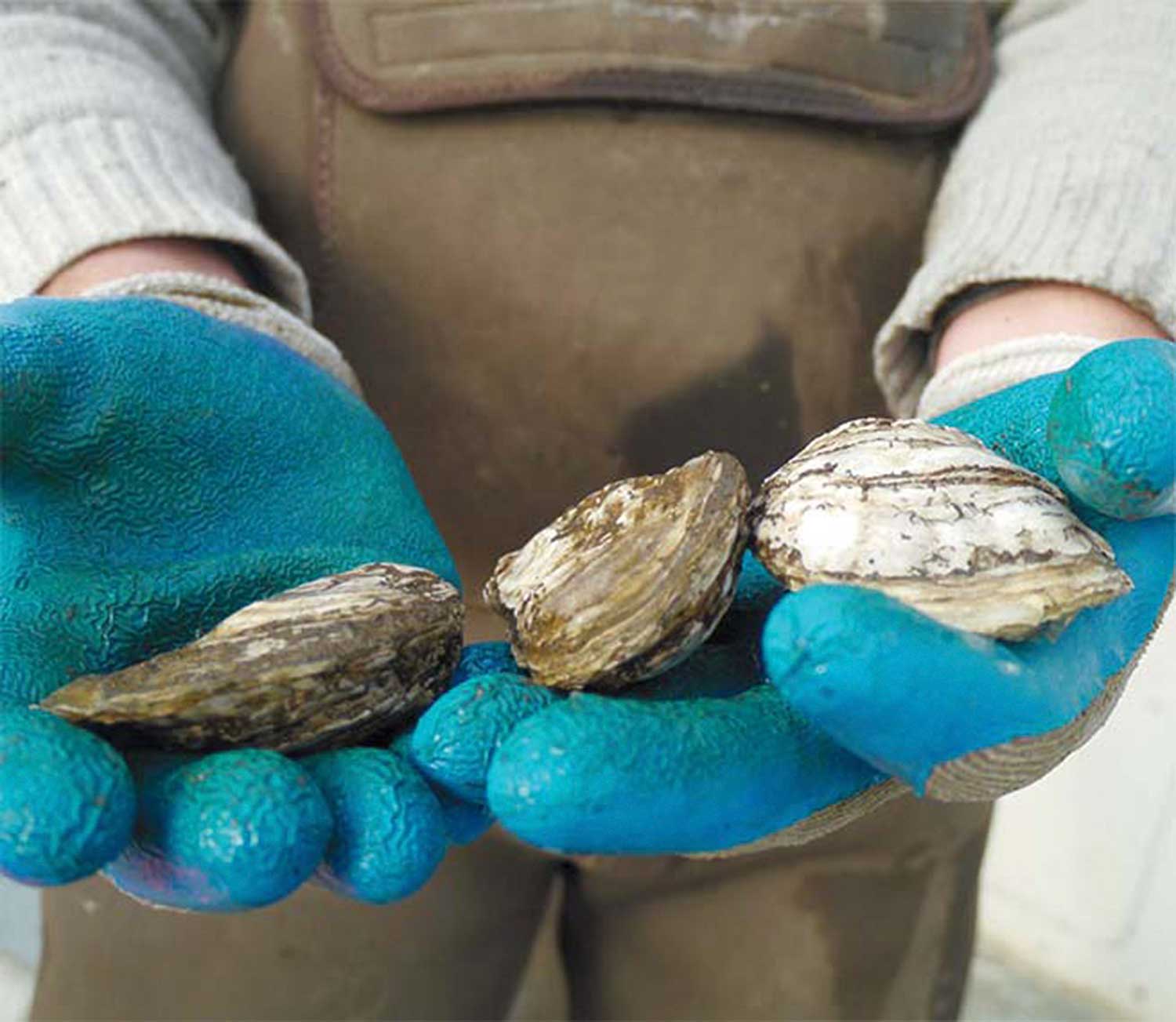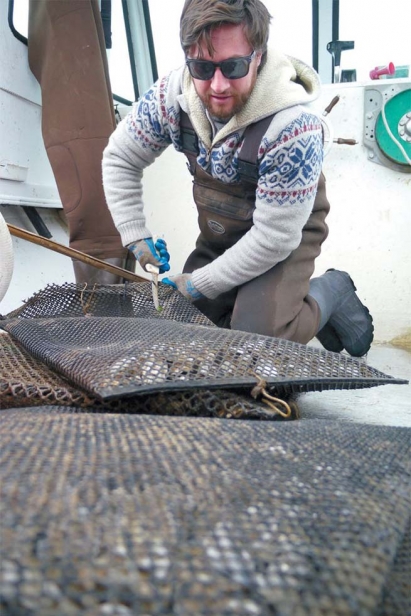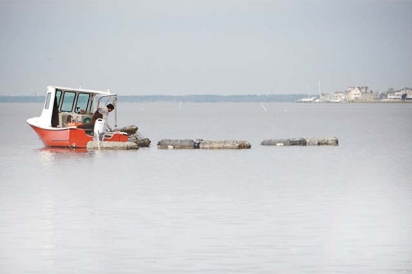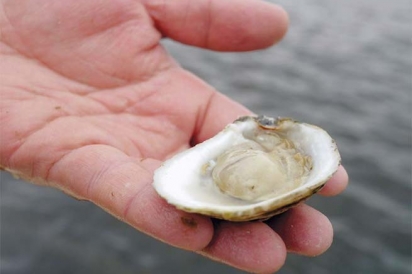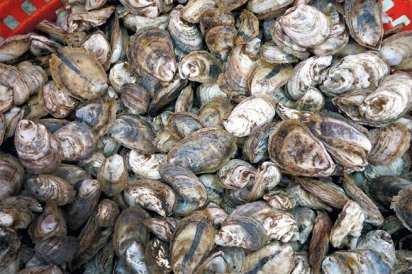The Oyster Farmer
Matt Gregg hopes to bring a once-thriving New Jersey industry back to prominence
It’s April 1 at Forty North Oyster Farms and Matt Gregg’s grow bags sit stacked and empty on the dock. Here in Mantoloking, the water’s still too cold for him to fill the bags with seed oysters and plant them in the mineral-rich Barnegat Bay.
Today’s water temperature is 42°. Oysters need 50° and above to feed and grow. Otherwise, like bears, they hibernate until it’s warm enough. That’s what the oysters Gregg planted last year are still doing. The season is late, Gregg says. Normally the water hits the 50s by late March.
Gregg, 30, a graduate of the University of Rhode Island, where he studied aquaculture, insists he’s not worried. Though only three years into oyster farming, he has the spirit and soul of a seasoned farmer. For all his planning, he knows there’s nothing he can do about the weather. He’s learned this lesson harder and faster than most.
Just five days before Hurricane Sandy devastated the Jersey Shore in October 2012, Gregg made the very first sale of his market-size oysters, and he was looking forward to many more sales to come. But Sandy had other plans. Along with destroying his boat and gear, the hurricane took with her most of his crop—of the 400,000 oysters Gregg had in the water, only a few thousand could be saved.
As we sit at a dockside picnic table, Gregg talks about it now as if Sandy were long ago. So much has happened since, he says. That includes starting over his oyster business.
“I had some stuff that survived. But most of it was lost or damaged,” he says. “I had to buy practically all new gear, a new boat, and had to put new seed oysters in the water.”
The money that Gregg made from his first oyster sale was far from what he needed to get back in business. State funding wasn’t available—no shellfish operations that Gregg knows of have received Sandy aid—and oysters are also not covered under government crop insurance.
On the plus side, Gregg did receive a $5,000 grant from Waves for Water under its Hurricane Sandy Relief Initiative, and he was able to raise an additional $5,000 from family, friends and strangers through a crowdfunding campaign similar to Kickstarter. In the process, Gregg also found a mentor and a minority partner in New York restaurateur Chris Cannon.
In a phone interview, Cannon tells me he had been researching Jersey farmers and producers to feature in his new restaurant, Jockey Hollow Bar & Kitchen in Morristown, and that’s when he found Gregg’s online fundraiser. The first time the two met, he says, they went out on the water and talked. By the time they docked, the partnership was sealed. Gregg now had the backing to keep Forty North going. And Cannon had the house oyster for his new multi-concept restaurant set to open this August. • That meeting occurred in April 2013. By August, Gregg was up and running again, with a new crop of 2,000 seed oysters snug in their grow bags, bouncing along the waves in their cages and gorging themselves on algae. Things were looking up. Already his Forty North oysters had been making waves of their own at food festivals and events as a new local, boutique oyster. Like wine, an oyster’s terroir (sometimes called “merroir,” meaning a certain area of the sea) depends on where it’s grown. In American Terroir, his book on North American regional agricultural specialties, Rowan Jacobsen writes, “Each bay has a unique blend of salts, minerals and algae species circulating in it, all of which have a profound impact on an oyster’s flavor. An oyster tastes like the sea, but the sea changes all along the coast.”
And always there’s the weather—including the direction of the wind and the amount of rain or lack of it. Each can have its say.
Last spring, Gregg’s oysters were coming out of hibernation, having finished their reserves to survive the winter, and were feeding again. The winds were blowing south for about a week and there was little rainfall. “For whatever reason,” he says, “May into June, the oysters were creamy and sweet.”
Oysters need a salinity of 10 to 35 parts per thousand to grow, Gregg explains; anything above or below will kill them. Pulling a refractometer out of his jacket pocket, Gregg leans down over the side of the dock and dips it into the water. Back at the table, he takes a reading of 27 parts per thousand. On a waterproof pad from his other pocket, he draws the salinity chart for oysters, from 0 to 35. Fresh water has 0 salinity and 35 is ocean. His Mantoloking oysters hover between 23 and 30. “We like a saltier oyster,” he says with a disarming smile. “So the closer to 30, the better.”
What about this past winter’s polar vortex, the coldest in his lifetime? Again, Gregg’s not worried. He countered the Artic blast by submerging his floating cages beneath the icy surface, where his oysters were protected and could hibernate in safety. “They should be fine,” he says. “They just might take a little longer to reach market size.” He’s expecting that many will reach that size—three inches measured by the length of the oyster’s shell—by May and June, with the rest continuing to grow, providing him with oysters year-round. May is also when he’ll plant 400,000 new seeds in preparation for future harvests. An oyster’s growth rate is site-specific, he says. His Mantoloking oysters take one or two years to reach market size. • Farming for oysters dates back to the Roman Empire, but Gregg uses an aquaculture system developed only 15 years ago. Today, in New Jersey, the transplanting of wild oyster seeds and the planting of oyster seeds started in hatcheries is necessary to keep the industry viable. During the 1800s and 1900s, New Jersey’s oyster industry rivaled that of New York City’s. From Sandy Hook to Cape May, the Jersey coastline boasted a wealth of these tasty bivalves. An egalitarian dish due to their abundance and affordable price, oysters were savored at high society dinners, in corner taprooms and at street stands alike.
But decades of overfishing and disease, in particular the deadly MSX disease in the 1950s and the Dermo parasite in the mid-1990s, have impacted East Coast oyster beds, especially those of the Delaware Bay. Today much credit for developing a disease-resistant oyster is given to Dr. Harold Haskin of Rutgers University, who first developed them in the early 1960s.
Another factor impacting oyster habitat was coastal development. Starting around 1978, new rules from the New Jersey Department of Environmental Protection were implemented to regulate coastal development in order to protect sensitive areas such as shellfish habitats.
Even the name of Gregg’s farm is a reminder of those early glory days. It sits at 40° north latitude, a swath of coastline that runs from Lavalette to New York City. Historically the area was prime waters for growing oysters. It is again, Gregg says. He already has his eye on two more Jersey sites to farm, and this summer will start seeding a new oyster farm in Peconic Bay off Long Island.
If Gregg has his way, New Jersey will again reign as a prime player in the oyster industry. With a national oyster renaissance under way, he says, there’s no reason for it not to be. “We’re way behind other states,” he notes. “We have a little more coastline than Massachusetts, but we only have about 12 oyster farmers. Massachusetts has 226 and their number is growing.” Granted, he says, Massachusetts has always had a coastal culture. “We did too. If we’re smart we can bring that heritage back.
“It’s a win-win-win situation,” he adds. “Just look at the benefits. It creates tax revenue for the state, oysters are environmentally beneficial, and it creates jobs through the production of a local product.”
The state of New Jersey appears to agree. Last June, new shellfish aquaculture rules were adopted by the N.J. Department of Environment Protection that are more friendly in regards to the permits that regulate the state’s oyster farmers. The permitting process for structural shellfish aquaculture like Gregg’s is now more streamlined and less costly. It remains to be seen whether the changes will be enough to encourage a new generation of oyster farmers. • “People like to try different flavor profiles when tasting oysters,” Gregg says. Having four oyster farms in different waters—although all within the 40° north latitude—will give Gregg four oysters with a distinct merroir. It was also make him the most local oyster option in more places.
In the end, it comes down to the joy of eating a good oyster. Gregg captures that in his branding efforts. The name of his Peconic Bay oysters, marketed as 40N Love Lane, refers to a little village on the North Fork of Long Island. “It’s been untouched by time,” Gregg says, “and reminds me of the way things may have been when oysters were a staple.” It’s also a reference to oysters as an aphrodisiac. “No other food has more to do with love than oysters,” he says.
His Mantoloking oysters are marketed as 40N Shore Point, his nod to local highway signage. “Eating an oyster can be nostalgic. It’s a taste of the sea,” he says. “We want people to get that same nostalgic feeling from one of our oysters that they do when heading down the Shore.” Gregg appears to have the right idea when it comes to branding his oysters—love and the Shore.
A SHORT GUIDE TO THE ART OF EATING AN OYSTER
First piece of advice, don’t say you don’t like oysters if you’ve never tasted one raw. Second, if you have tasted one and didn’t like it, try again. Chances are good that, as with wine, you didn’t find one to your palate preference. Or, a better bet, you had it somewhere that doesn’t specialize in oysters and the quality or freshness was poor. Third, relax and enjoy. There’s no correct way to slurp oysters. But there are a few rules to follow to enjoy their full experience and flavor.
Rule #1: Taste with your eyes and nose first. Most oyster meat is gray, although color can vary from creamy white to pink and tan—some even has a greenish hue. It all depends on its place of origin. But all meat should be bright, moist and glistening, not dull or dry. It should fill most of the shell, often called the cup, and hold a good amount of its liquor, or juice. The oyster should smell of the sea—like your first whiff of the ocean as you drive down the shore. Evocative and seductive—not bad-smelling.
Rule #2: Don’t use the tiny oyster fork to spear the meat into your mouth. Instead, use it to loosen the meat from the shell, careful not to spill any of the liquor. Bring the shell to your mouth, tilt it slightly and sip some of the liquor. Tilting more, slurp the oyster and remaining liquor (preferably from the wide end) and chew once or twice before swallowing. Biting into an oyster, rather than just swallowing, releases the full flavor so you can taste all the nuances of the water where the oyster was raised.
Rule #3: Eat one naked before adding a condiment. Oysters sometimes come with lemon wedges or different sauces like Tabasco, cocktail, or mignonette, a sauce made of red wine, shallots and black pepper. You just might find that naked is best. Then try a spritz of lemon or a drizzle of the mignonette. Either one adds to the oyster’s flavor profile, so try the same oyster with one or both and forget the disguising hot sauces.
Rule #4: Try several different oysters, ordering at least two of each to better distinguish their flavor and texture.
That’s it—except oysters, like wine, are a great social button. People like to talk about them. And like wine, oysters are described according to taste and texture. Size isn’t a consideration, as it depends on the oyster’s place of origin.
To help you sound like an oyster snob, here are a few buzzwords to keep in your lexicon. For taste, use salty, sweet, buttery, briny, melon, woody, grassy and metallic. For texture, try firm, soft, chewy, plump, pillowy and creamy.
One more tip: When you’ve finished tasting all the oysters on your plate, turn the shells over to admire and note their differences. It also is a polite way to let your server know that you have finished— and enjoyed! —Diana Cercone
FOR MORE THAN SLURPING
Oysters are a keystone species in coastal ecosystems, plus they can help mitigate future storm damage.
No commercial shellfish plays a bigger role in the environment than the oyster.
Like coral, oysters are environmental engineers. Where freshwater rivers meet the salty ocean, oysters cling to the shells of their kin to form vast three-dimensional reefs. These oyster reefs are ecological lynchpins—acting as vital nurseries for commercial fish as well as harboring multitudes of other marine life. They also actively clean the surrounding water. A single adult oyster can filter up to 50 gallons of water each day as it feeds on plankton.
In the 19th and early 20th centuries, endless miles of oyster reefs could be found in estuaries all along the New Jersey coastline. But decades of overfishing, dredging and poisonous water pollution destroyed almost all of the state’s natural reefs. Today, New Jersey’s few remaining reefs are farmed cautiously, and coastal water quality continues to improve—largely thanks to the federal Clean Water Act of 1972—but oysters are still struggling to make any sort of comeback.
The reason is simple: When oysters permanently settle down at the beginning of their life, they usually attach to the shells of other established oysters. But without preexisting oyster reefs—or manmade oyster scaffolding for the shellfish to grab hold of—reintroduced oysters drift away into the sea. In order for New Jersey to recover these lost reefs, they’ll need to be painstakingly reseeded, one project at a time.
The difficulty of reestablishing these important shellfish is doubly tragic when you consider how oysters could help us weather the expected effects of climate change. It’s a fact that New Jersey can anticipate rising waters and increasing storminess. And while severe storms like Hurricane Sandy can rip up young beds of oysters—as happened at Matt Gregg’s Forty North—established oyster reefs actually temper and subdue storm surges and crashing waves, thereby minimizing damage to coastal communities.
The case for a focused effort to reestablish oysters across the New Jersey coast should be an easy one, but current efforts have been hampered by a legal snarl.
Because oysters filter the water around them, they also act as sponges for most water-bound pollutants. For this reason, most oysters from reconstructed reefs along the coast would not be safe to eat. Out of fear that polluted oysters would illegally end up on dinner plates, in 2010 the New Jersey Department of Environmental Protection banned oyster restoration efforts in waters currently considered unsafe to grow commercial shellfish. [Matt Gregg’s Forty North and all other permitted New Jersey oyster farms raise oysters in approved waters.]
New Jersey’s coastal water quality fluctuates dramatically, and while the state’s few oyster farms, in places such as Cape May and Mantoloking, rightly claim healthy shellfish, in many places where coastal communities need oysters the most, water quality is still dismal.
For example, the communities alongside Raritan Bay, hit particularly hard by Hurricane Sandy, can’t claim waters clean enough for oyster restoration projects, although they once sported miles of protective oyster reefs.
The oyster reefs currently being farmed are not insulated from the effects of climate change either. Oysters require a particular mix of fresh and salt water to grow, and as rising waters threaten to push back coastlines, today’s oyster farms could become increasingly salty—at best, only affecting the farmed shellfishes’ flavor, and at worst, threatening to tank the remaining places we grow New Jersey oysters today. —William Herkewitz


